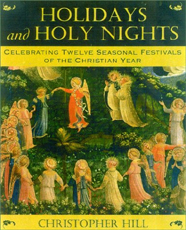"The Church is the great repository of mystery, but for the last century or so, the face of the mainstream churches have been pretty much the rational, main-street, daylight face of God — theology, ethics, charity and social outreach. Paul would have called it law and works," writes Christopher Hill, who has been a broadcast producer, rock critic, editor, and communications director for the Episcopal Diocese of Milwaukee. He continues: "The sixties awakened a thirst for a face of God that the churches had long since ceded to the arts, folklore, and popular culture — the night side of God. When we're cut off from the moon, the night, and the waters of mystery, the spiritual world is blinding and blisteringly arid. Mystery refreshes us. Mystery is a cool dark underground stream, a tributary of living water that bubbled up into that well in a dusty Middle-Eastern village where Jesus stopped at midday and spoke to a Samaritan woman. When our roots are sunk into mystery, we flourish like trees planted by a stream." With that kind of perspective and wonderful writing style, it's no wonder that Hill has received awards from the Episcopal Communicators and the Associated Church Press.
This awe-inducing resource probes the poetic, symbolic, natural, folkloric, and psychological nuances of the church year. Hill consciously swerves away from a scholarly approach and chooses instead to make this a gazette filled with hundreds of spicy, thought-provoking, and practical details about The Feast of Michael and All Angels, Halloween, The Feast of All Saints, The Feast of All Faithful Departed, Advent, Christmas Eve, Twelfth Night, the Feast of Epiphany, The Feast of St. Brigid of Ireland, The Purification of St. Mary the Virgin, The Annunciation of the Lord, Easter Vigil, Pentecost, The Nativity of St. John the Baptist, The Feast of St. Mary Magdalene, and the Feast of the Transfiguration. Each chapter includes a meditation, a story giving the background of the day, and several ways to "enter the season."
We loved the use of paintings such as "The Annunciation" by Henry Ossawa Tanner and "Easter Morning" by Caspar David Friedrich to catalyze our appreciation of these festivals. Hill also uses snippets of poems and does imaginative treatments of familiar material, demonstrating an openness to all the subtle and sneaky manifestations of the Divine in our lives. Here's just one example of the many tidbits of information here:
"In many Eastern Orthodox churches, Epiphany features a beautiful rite of the blessing of water. Weather permitting, congregations gather at some nearby body of open water for a ritual that goes back to ancient Egypt and celebrates the streams of living water that Christ sets flowing at this time."
This paperback helps us savor the manifold mysteries of God, time, and the cycles of nature. Hill is right — a little mystery is very refreshing.
